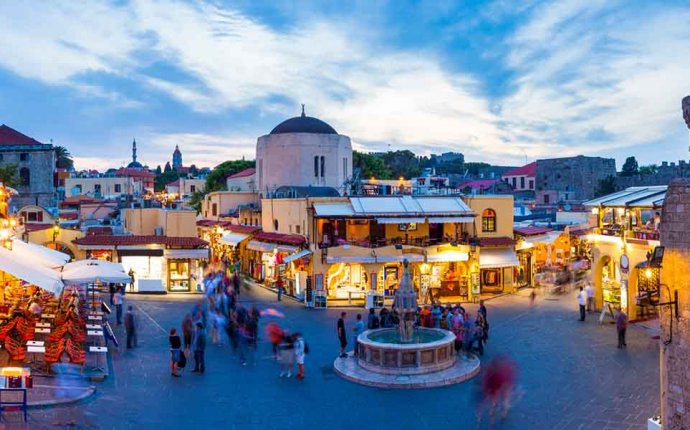
Rhodes town Greece
|
The Old City of Rhodes with a current population of 6, 000 inhabitants is surrounded by medieval walls with seven gates: Gate of the Naval Station, Gate of Agios Ioannis, Gate of Agia Ekaterini, Gate of the Apostle Paul, Gate of Amboise, Gate of Agios Athanassios and the Gate of the Port. To enter any of these gates is to enter another world. Now it happens to be a world of tourist shops, restaurants, cafes and museums, more like a Turkish bazaar than any Greek city, but anyone with imagination can't help but be touched by the history of the place where a handful of Knights were the last Christian holdouts in a part of the world that had become completely dominated by Muslims, in particular the Ottoman Turks. |
|
When the city finally did fall after a siege that exhausted both defenders and besiegers the remaining Knights were offered safe passage and on January 1st of 1523 left Rhodes along with 5000 of the Christian inhabitants of the island who chose to leave rather than live under the Sultan. In the defense of the city 2000 Christians had died. The Turks had lost 50, 000 trying to take it. This is not, however just an old town filled with ghosts of the past. The old city of Rhodes is a living, vibrant community with many homes and business, not all of them connected to tourism. The Medieval City was divided into three parts: the northern part included the Acropolis of the Knights and the Palace of the Grand Master while the southern part include Hora, were the commoners lived. The Jewish Quarter is the third section and the least developed commercially in terms of tourism and is mostly residential, though the Hora is also residential mixed with bars, restaurants, cafes and shops. |
|
As you enter the city either from the commercial harbor through the Gate of Navarhou or from the new town through the gate of Eleftherias you see the remains of the 3rd century temple of Aphrodite, and behind it is the Lodge of the Knights of Aiberne, built in 1507. Today the building houses the governor's office. Next to it is the Lodge of the Battalion of England and the first hospital of the Knights, which was built by the Grandmaster in 1440, which today is the Library of the Archaeological Society. The 'New' Hospital houses the town's Archaeological Museum which is impressive not only because of the large number of relics but because the building itself is so monumental and has been the Archaeological museum since 1916. Don't miss the beautiful Aphrodite of Rhodes (like I did) which is contained in a small room that I somehow didn't see. The problem with the old city is that after awhile you have seen so many antiquities that your mind goes numb and you wander around like you are in a daze. For that reason I suggest not trying to see it all at once and to plan your trip so you spend a little extra time in Rhodes than you would on an island with less to offer. |
|
The most beautiful and interesting part of the Old City for me is the street of Knights, the most important street of the medieval town. The street is completely restored or preserved beautifully, and is lined by the buildings where the holy warriors spent their time in prayer or military practice though it is hard to imagine this going on simultaneously unless you have ever visited the West Campus residence halls of Duke University. The Street of the Knights stretches from the New Hospital-Archaeological Museum to the Grandmaster's Palace where the Lodge of the Battalion of France, one of the most beautiful buildings on the island, stands. Next to it stands the chapel of the same name with the beautiful statue of Virgin Mary and the holy infant. The nearby church of Agios Dimitrios is built upon the ruins of the ancient temple of Dionysus. |